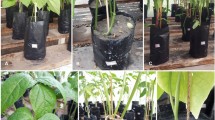Abstract
Fourty-four strains of Fusarium oxysporum were isolated from plants of melon with Fusarium wilt symptoms. Among these strains, thirty-nine were characterized for their pathogenicity on melon. Thirty-seven strains belonged to known races of F. oxysporum f. sp. melonis, while two strains were non-pathogenic. Four strains belonged to race 0, seven to race 1, four to race 2, and twenty-two to race 1,2. Beauvericin was produced by thirty-six strains in a range from 1 to 310μgg−1. Eight isolates of race 1,2 did not produce the toxin. In addition, of the two non-pathogenic strains, only one strain produced the toxin (290μgg−1). The production of enniatin A1, enniatin B1, and enniatin B was also investigated. Enniatin B was the only enniatin detected, being produced by eleven strains belonging to all the races, with a range of production from traces to 60μgg−1. Finally, melon fruits belonging to two different cultivars (Cantalupo and Amarillo) were artificially inoculated with one strain of F. oxysporum f. sp. melonis (ITEM 3464). Beauvericin was detected in the fruit tissues of both cultivars at a level of 11.2 and 73.8μgg−1, respectively. These data suggest that the production of both the toxins is not related to the pathogenicity of F. oxysporum f. sp. melonis, nor to the differential specificity of the races. The results confirm that beauvericin is a common metabolite of phytopathogenic Fusarium species.
Similar content being viewed by others

References
Abdalla MY, Al-Rokibah A, Moretti A and Mulè G (2000) Pathogenicity of toxigenic Fusarium proliferatum from date palm in Saudi Arabia. Plant Disease: 84: 321–324
Appel DJ and Gordon TR (1996) Relationships among pathogenic and nonpathogenic isolates of Fusarium oxysporum based on the partial sequence of the intergenic spacer region of the ribosomal DNA Molecular Plant-Microbe Interaction 9: 125–138
Bernardini M, Carilli A, Pacioni G and Santurbano B (1975) Isolation of beauvericin from Paecilomyces fumosoroseus. Phytochemistry 14: 1865
Bouhot D (1981) Some aspects of the pathogenic potential in formae speciales and races of Fusarium oxysporum on Cucurbitaceae. In: Nelson PE, Toussoun TA, and Cook RJ (eds) Fusarium: Diseases, Biology and Taxonomy (pp 318–326) Pennsylvania State University, University Park, PA
Brigati S and Gori P (1986) Prevenzione dei marciumi da Fusarium oxysporum dei meloni dopo la raccolta. Informatore Fitopatologico 5: 33–34
Burmeister HR and Plattner RD (1987) Enniatin production by Fusarium tricinctum and its effects on germinating wheat seeds. Phytopathology 77: 1483–1487
Desjardins AE and Hohn TM (1997) Mycotoxins in plant pathogenesis. Molecular Plant-Microbe Interaction 10: 147–152
Gaumann E, Naef-Roth S and Kern H (1960) Zur phytotoxischen Wirksamkeit der Enniatine. Phytopathologische Zeitschrift 40: 45–51
Gupta S, Krasnoff SB, Underwood NL, Renwick JAA and Roberts DW (1991) Isolation of beauvericin as an insect toxin from Fusarium semitectum and Fusarium moniliforme var. subglutinans. Mycopathologia 115: 185–189
Hamill RL, Higgens CE, Boaz HE and Gorman M (1969) The structure of beauvericin: A new depsipeptide antibiotic toxic to Artemia salina. Tetrahedron Letters 49: 4255–4258
Herrmann M, Haese A and Zocher R (1996) Effect of disruption of the enniatin synthetase gene on the virulence of Fusarium avenaceum. Molecular Plant-Microbe Interaction 9: 226–232
Jacobson DJ and Gordon TR (1991) Fusarium oxysporum f. sp. melonis: A case study of diversity within a forma specialis. Phytopathology 81: 1064–1067
Jacobson DJ and Gordon TR (1990) Further investigations of vegetative compatibility within Fusarium oxysporum f. sp. melonis. Canadian Journal of Botany 68: 1245–1248
Lemmens M, Kouri K and Lemmens-Gruber R (2000) Patch clamp studies on the electrophysiological properties of the beauvericin channel-incorporated in artificial biological membranes. 6th European Fusarium Seminar, 11-16 September 2000 (pp 43–44) Berlin (Abstract)
Logrieco A, Moretti A, Castella G, Kostecki M, Golinski P, Ritieni A and Chelkoswski J (1998) Beauvericin production by Fusarium species. Applied and Environmental Microbiology 64: 3084–3088
Logrieco, A., Moretti A, Altomare C, Bottalico A and Carbonell Torres E (1993) Occurrence and toxicity of Fusarium subglutinans from Peruvian maize. Mycopathologia 122: 185–190
Monti SM, Fogliano V, Logrieco A, Ferracane R and Ritieni A (2000) Simultaneous determination of beauvericin, enniatins, and fusaproliferin by high performance liquid chromatography. Journal of Agricultural and Food Chemistry 48: 3317–3320
Moretti A, Logrieco, A, Bottalico, A, Ritieni A, Fogliano V and Randazzo G (1996) Diversity in beauvericin and fusaproliferin production by different populations of Gibberella fujikuroi (Fusarium section Liseola). Sydowia 48: 45–56
Moretti, A., Logrieco A, Bottalico A, Ritieni A, Randazzo G and Corda P (1995) Beauvericin production by Fusarium subglutinans from different geographical areas. Mycological Research 99: 282–286
Nelson PE, Toussoun A and Marasas W (1983) Fusarium species: Anillustrated manual for identification. The Pennsylvania State University Press, University Park, PA
Plattner RD and Nelson PE (1994) Production of beauvericin by a strain of F. proliferatum isolated from corn fodder for swine. Applied and Environmental Microbiology 60: 3894–3896
Risser G, Banihashemi Z and Davis DW (1976) A proposed nomenclature of Fusarium oxysporum f.sp. melonis races and resistance genes in Cucumis melo. Phytopathology 66: 1105–1106
Sagakuchi M, Moretti A, Endo E, Matsuda Y, Toyoda H and Ouchi S (2000) An approach to the use of plant sensitivity for simple detection of mycotoxins. In: Proceedings of First Asian Conference of Plant Pathology, August 2000 (pp 262–279), Kuala Lumpur, Malaysia
Author information
Authors and Affiliations
Rights and permissions
About this article
Cite this article
Moretti, A., Belisario, A., Tafuri, A. et al. Production of Beauvericin by Different Races of Fusarium Oxysporum F. sp. Melonis, The Fusarium Wilt Agent of Muskmelon. European Journal of Plant Pathology 108, 661–666 (2002). https://doi.org/10.1023/A:1020674929084
Issue Date:
DOI: https://doi.org/10.1023/A:1020674929084



